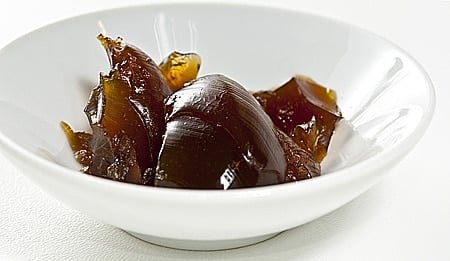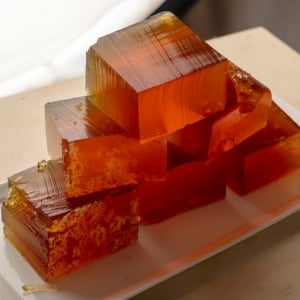
Glace de viande is an ultra-concentrated stock used to enliven pan sauces or soups; it’s usually made with veal. Glace, pronounced glah-ss, is also the closest thing I know to making your own bouillon cubes — only this is infinitely better. Looks like duck Jell-O, doesn’t it?
The only problem with glace is that is a pain to make. If you have other things to do, this recipe can take several days. Really. But it’s still worth it. Take your time and go with it.
Once its made, glace lasts two weeks or more in the fridge and a year or more in the freezer. Freeze it in blocks with an ice cube tray, or in small glass jars. Remember a little goes a long way.
Then, when you need a bomb of meaty flavor, grab some demi-glace and drop it into the sauce or soup.
If you make this with domestic ducks or geese, cut as much fat off them as you can, and note that you will only need 3-4 duck carcasses or 2-3 goose carcasses.
French Glace de Viande
Ingredients
- 5-7 pounds meat and bones
- 1-2 pounds feet, cartilage and/or silverskin
- Kosher or sea salt
- 2 chopped onions
- 4 chopped carrots
- 5 chopped celery sticks
- 1/2 pound mushrooms, chopped (optional)
- 1 fennel bulb, chopped (optional)
- Stems from 1 bunch parsley
- Large sprig of fresh thyme or 1 tablespoon dried
- Large sprig rosemary or 1 tablespoon dried
- 1 tablespoon cracked black pepper
- 4 bay leaves
- 1 tablespoon crushed juniper berries (optional)
Instructions
- Salt the meat and bones well. Set aside for 15 minutes while you heat the oven to 400°F. Put the meat and bones in a large roasting pan and cook at 400°F for 1 hour, or until well browned.
- Meanwhile, toss the silverskin and cartilaginous bits into a large stockpot. If you have feet, chop them roughly, or score them all over with a knife. This opens the feet up to the broth, so all that gelatin can get into it. This is what makes the concentrated broth set up solid. Do not skip this. Put the feet in the stockpot, too.
- Once the meat and bones are roasted, put them in the pot and cover everything with cold water almost all the way to the top. (cold water + cartilaginous bits = better gelatin later.) Turn the heat to medium-high and cover the pot. You need to be around as this heats up, because this is the one danger spot: The broth cannot boil. If I have other things to do, I don't cover the pot and I only set the heat to medium. This way it can take an hour for the broth to hit a simmer, and I don't have to stand there watching it.
- Skim any froth that surfaces. Do this as many times as needed. As I mention above, I let the broth cook at the steaming point until I go to bed, then drop it all the way down, cover the pot and let it steep like tea overnight. You need a minimum of 4 hours, though, and 12 isn't too much.
- Once the meats have simmered, add all the vegetables, herbs and spices. Simmer this for 90 minutes to 2 hours.
- Strain the stock. Put paper towels in a strainer and set the strainer over a large bowl or pot. Ladle the stock through this to remove all debris and particles.
- Clean your pot and return the broth to it. Bring this to a bare simmer, then drop the heat back to the steaming point. Let this cook down slowly by at least half, and two-thirds to three-quarters is better. You will need to skim it again.
- In the end, you should have a clear, thick broth. You'll want to strain it once more, exactly how you strained it initially, through the paper towels. Pour the finished glace de viande into small containers, and refrigerate. It should set up and become a gelatin.
Notes
Nutrition
Nutrition information is automatically calculated, so should only be used as an approximation.
